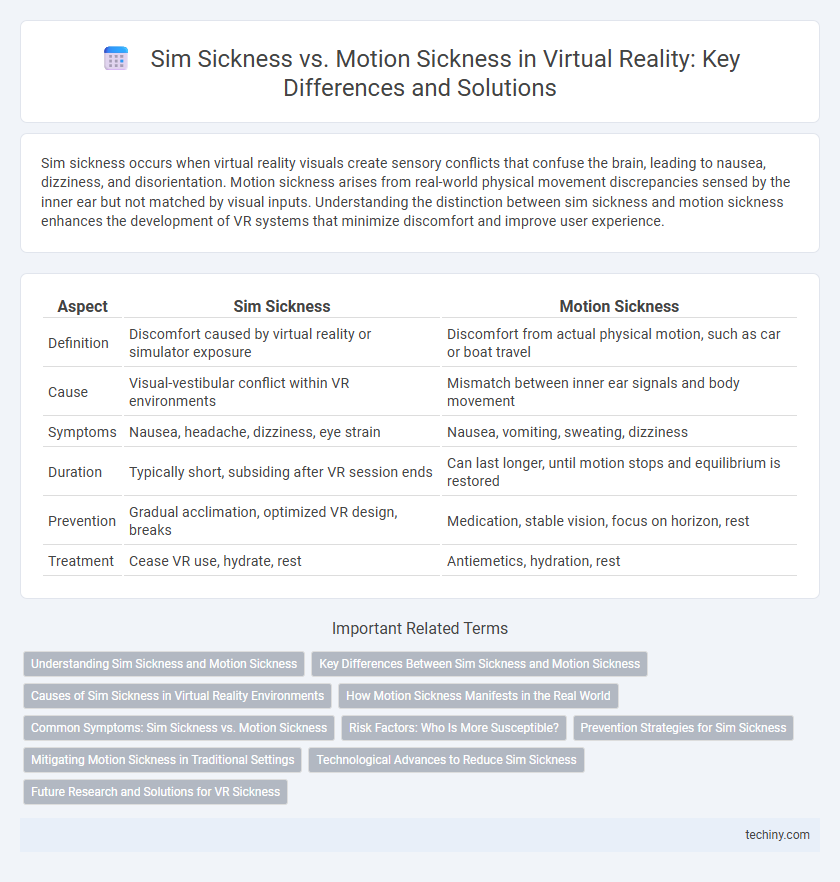Sim sickness occurs when virtual reality visuals create sensory conflicts that confuse the brain, leading to nausea, dizziness, and disorientation. Motion sickness arises from real-world physical movement discrepancies sensed by the inner ear but not matched by visual inputs. Understanding the distinction between sim sickness and motion sickness enhances the development of VR systems that minimize discomfort and improve user experience.
Table of Comparison
| Aspect | Sim Sickness | Motion Sickness |
|---|---|---|
| Definition | Discomfort caused by virtual reality or simulator exposure | Discomfort from actual physical motion, such as car or boat travel |
| Cause | Visual-vestibular conflict within VR environments | Mismatch between inner ear signals and body movement |
| Symptoms | Nausea, headache, dizziness, eye strain | Nausea, vomiting, sweating, dizziness |
| Duration | Typically short, subsiding after VR session ends | Can last longer, until motion stops and equilibrium is restored |
| Prevention | Gradual acclimation, optimized VR design, breaks | Medication, stable vision, focus on horizon, rest |
| Treatment | Cease VR use, hydrate, rest | Antiemetics, hydration, rest |
Understanding Sim Sickness and Motion Sickness
Sim sickness occurs when there is a sensory conflict between visual inputs from the virtual environment and the absence of corresponding physical movement, leading to symptoms such as dizziness, nausea, and disorientation. Motion sickness arises from a mismatch between vestibular signals and physical movement, commonly experienced in real-world scenarios like traveling by car or boat. Understanding the distinct causes and physiological responses of sim sickness and motion sickness is crucial for developing effective mitigation techniques in virtual reality applications.
Key Differences Between Sim Sickness and Motion Sickness
Sim sickness arises from sensory mismatches experienced in virtual reality environments, primarily caused by visual stimuli conflicting with the vestibular system, whereas motion sickness results from physical movement creating a disconnect between the inner ear's balance signals and visual perception. Symptoms of sim sickness often include eye strain, headaches, and nausea triggered by prolonged VR exposure, while motion sickness typically manifests during real-world travel involving cars, boats, or planes. Understanding these key differences helps in developing targeted mitigation strategies like optimizing frame rates for VR systems or using physical stabilizers in transportation.
Causes of Sim Sickness in Virtual Reality Environments
Sim sickness in virtual reality primarily arises from sensory conflict between visual inputs and the vestibular system, where the eyes perceive motion while the body remains stationary. This mismatch leads to symptoms such as nausea, dizziness, and disorientation. Factors like low frame rates, latency, field of view discrepancies, and improper calibration of VR hardware significantly contribute to the onset of sim sickness.
How Motion Sickness Manifests in the Real World
Motion sickness manifests in the real world through symptoms such as dizziness, nausea, sweating, and headache, typically triggered by conflicting sensory inputs between the inner ear and visual system during physical movement. It occurs during activities like car rides, boating, or air travel when the brain receives mismatched signals about balance and motion. Understanding the biological mechanisms behind motion sickness helps develop better treatments and preventive measures for sufferers.
Common Symptoms: Sim Sickness vs. Motion Sickness
Common symptoms of sim sickness include nausea, dizziness, headaches, and eye strain caused by sensory mismatch in virtual reality environments. Motion sickness typically presents with nausea, sweating, dizziness, and cold clammy skin due to conflicting signals between the inner ear and visual system during physical movement. Both conditions share nausea and dizziness, but sim sickness often involves more visual discomfort, while motion sickness is strongly linked to physical motion cues.
Risk Factors: Who Is More Susceptible?
Risk factors for simulator sickness versus motion sickness differ, with simulator sickness more commonly affecting individuals new to virtual reality or those with heightened visual-vestibular sensitivity. People prone to migraine, inner ear disorders, or anxiety may experience exacerbated symptoms in VR environments. Age and gender also influence susceptibility, as younger users and females report higher incidence rates of simulator sickness compared to motion sickness risk profiles.
Prevention Strategies for Sim Sickness
Prevention strategies for sim sickness focus on optimizing virtual reality hardware and software, such as reducing latency to below 20 milliseconds and increasing frame rates to at least 90 frames per second to ensure smooth visual motion. Implementing gradual exposure to VR environments and allowing users to control their movement helps minimize sensory mismatch, a key cause of sim sickness. Using ergonomic designs like wider field-of-view headsets and providing breaks every 20-30 minutes further decrease symptoms and improve user comfort during VR experiences.
Mitigating Motion Sickness in Traditional Settings
Mitigating motion sickness in traditional settings involves optimizing sensory inputs to reduce the disconnect between visual and vestibular systems, often using stable reference points and controlled movement stimuli. Techniques such as gradual exposure, controlled lighting, and minimizing abrupt motions help the brain reconcile conflicting signals. Incorporating ergonomic designs and anti-nausea remedies further enhances user comfort during prolonged VR or motion-based experiences.
Technological Advances to Reduce Sim Sickness
Technological advances in virtual reality, such as improved head tracking, higher frame rates, and low-latency rendering, are significantly reducing sim sickness by minimizing sensory discrepancies that cause discomfort. Innovations like adaptive field of view and foveated rendering help decrease motion blur and visual latency, enhancing user comfort and immersion. VR hardware with ergonomic design and real-time motion prediction further mitigates symptoms, making extended VR sessions more feasible for users.
Future Research and Solutions for VR Sickness
Future research on VR sickness aims to develop adaptive algorithms that personalize motion cues to individual user sensitivities, reducing sensory conflicts responsible for sim sickness. Innovations in real-time biometric monitoring and AI-driven feedback loops hold promise for detecting early symptoms and dynamically adjusting VR experiences to prevent motion sickness. Exploring novel hardware designs, such as improved display refresh rates and vestibular stimulation integration, will enhance user comfort and expand VR applications across diverse populations.
Sim sickness vs Motion sickness Infographic

 techiny.com
techiny.com